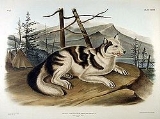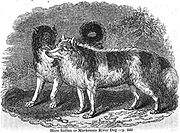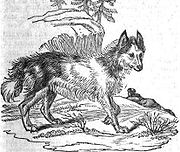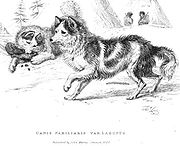
Hare Indian dog
Encyclopedia
The Hare Indian dog is an extinct breed
of dog
, formerly found in northern Canada
and originally bred by the Hare Indians as a coursing dog
. It was bred for speed, being much like a coyote
, but it gradually lost its usefulness as aboriginal
hunting
methods declined. The breed lost its separate identity through interbreeding with other dogs in the 19th century.

 The Hare Indian dog was a diminutive, slenderly built breed with a small head and a narrow, pointed and elongated muzzle. Its pointed ears were erect and broad at the base, and closer together than those of the Canadian Eskimo dog
The Hare Indian dog was a diminutive, slenderly built breed with a small head and a narrow, pointed and elongated muzzle. Its pointed ears were erect and broad at the base, and closer together than those of the Canadian Eskimo dog
. Its legs were slender and rather long. The tail was thick and bushy, and it curled upwards over its right hip, though not to the extent of the Canadian Eskimo dog. The fur was long and straight, the base colour being white with large, irregular grayish black patches intermingled with various brown shades. The outside of the ears was covered with short brown hair which darkened at the base. The fur in the inside of the ears was long and white. The fur of the muzzle was short and white, as with the legs, though it became longer and thicker at the feet. Black patches were present around the eyes. Like the wolves with which it was sympatric, it had long hair between its toes, which projected over the soles, with naked, callous protuberances being present at the root of the toes and soles, even in winter. In size, it was intermediate to the coyote
and the American red fox.
. In its native homeland, the breed was not known to bark
, though puppies born in Europe learned how to imitate the barking of other dogs. When hurt or afraid, it howled like a wolf, and when curious, it made a sound described as a growl building up to a howl.
In the above quote, the fact that the Indian claimed he thought it was a fox, gives us a clear indication of the appearance and size of the breed.

 It is thought by one writer that the breed originated from a cross between native Tahltan dog
It is thought by one writer that the breed originated from a cross between native Tahltan dog
s and dogs brought to the North American continent by Viking
explorers, as it bears strong similarities to Iceland
ic breeds in appearance and behavior. Sir J. Richardson of Edinburgh
, on the other hand, who studied the breed in the 1820's, in their original form before being diluted by crossings with other breeds, could detect no decided difference in form between this breed and a coyote, and surmised that it was a domesticated version of the wild animal. He wrote, "The Hare Indian or Mackenzie River Dog bears the same relation to the prairie wolf [coyote] as the Esquimeaux Dog [Malamute] does to the great grey wolf." The breed seemed to be kept exclusively by the Hare Indians and other neighboring tribes, such as the Bear, Mountain, Dogrib, Cree
, Slavey and Chippewa tribes living in the Northeastern Territories of Canada and the United States around the Great Bear Lake
, Southwest to Lake Winnipeg
and Lake Superior
and West to the Mackenzie River
. They were valued by the Indians as coursorial hunters
, and they subsisted almost entirely on the produce of each hunt. Although not large enough to pose a danger to the moose
and reindeer
they hunted, their small size and broad feet allowed them to pursue large ungulate
s in deep snow, keeping them at bay until the hunters arrived. It was too small to be used as a beast of burden
. It was the general belief among the Indians that the dog's origin was connected to the Arctic fox
. When first examined by European biologists, the Hare Indian dog was found to be almost identical to the coyote in build (save for the former's smaller skull) and fur length. The first Hare Indian dogs to be taken to Europe
were a pair presented to the Zoological Society of London
, after Sir John Richardson
's and John Franklin
's Coppermine Expedition of 1819–1822
. Though originally spread over most of the northern regions of North America, the breed fell into decline after the introduction of firearm
s made its hunting abilities unnecessary. It gradually intermingled with other breeds such as the Newfoundland dog, the Canadian Eskimo dog
and Mongrel
s.
Dog breed
Dog breeds are groups of closely related and visibly similar domestic dogs, which are all of the subspecies Canis lupus familiaris, having characteristic traits that are selected and maintained by humans, bred from a known foundation stock....
of dog
Dog
The domestic dog is a domesticated form of the gray wolf, a member of the Canidae family of the order Carnivora. The term is used for both feral and pet varieties. The dog may have been the first animal to be domesticated, and has been the most widely kept working, hunting, and companion animal in...
, formerly found in northern Canada
Canada
Canada is a North American country consisting of ten provinces and three territories. Located in the northern part of the continent, it extends from the Atlantic Ocean in the east to the Pacific Ocean in the west, and northward into the Arctic Ocean...
and originally bred by the Hare Indians as a coursing dog
Coursing
Coursing is the pursuit of game or other animals by dogs—chiefly greyhounds and other sighthounds—catching their prey by speed, running by sight and not by scent. Coursing was a common hunting technique, practised by the nobility, the landed and wealthy, and commoners with sighthounds and lurchers...
. It was bred for speed, being much like a coyote
Coyote
The coyote , also known as the American jackal or the prairie wolf, is a species of canine found throughout North and Central America, ranging from Panama in the south, north through Mexico, the United States and Canada...
, but it gradually lost its usefulness as aboriginal
Indigenous peoples
Indigenous peoples are ethnic groups that are defined as indigenous according to one of the various definitions of the term, there is no universally accepted definition but most of which carry connotations of being the "original inhabitants" of a territory....
hunting
Hunting
Hunting is the practice of pursuing any living thing, usually wildlife, for food, recreation, or trade. In present-day use, the term refers to lawful hunting, as distinguished from poaching, which is the killing, trapping or capture of the hunted species contrary to applicable law...
methods declined. The breed lost its separate identity through interbreeding with other dogs in the 19th century.
Appearance


Canadian Eskimo Dog
The Canadian Eskimo Dog is an Arctic breed of dog , which is often considered to be North America’s oldest and rarest remaining purebred indigenous domestic canine. Other names include Qimmiq...
. Its legs were slender and rather long. The tail was thick and bushy, and it curled upwards over its right hip, though not to the extent of the Canadian Eskimo dog. The fur was long and straight, the base colour being white with large, irregular grayish black patches intermingled with various brown shades. The outside of the ears was covered with short brown hair which darkened at the base. The fur in the inside of the ears was long and white. The fur of the muzzle was short and white, as with the legs, though it became longer and thicker at the feet. Black patches were present around the eyes. Like the wolves with which it was sympatric, it had long hair between its toes, which projected over the soles, with naked, callous protuberances being present at the root of the toes and soles, even in winter. In size, it was intermediate to the coyote
Coyote
The coyote , also known as the American jackal or the prairie wolf, is a species of canine found throughout North and Central America, ranging from Panama in the south, north through Mexico, the United States and Canada...
and the American red fox.
Temperament
The Hare Indian dog was apparently very playful, and readily befriended strangers, though it was not very docile, and disliked confinement of any kind. It apparently expressed affection by rubbing its back against people, similar to a catCat
The cat , also known as the domestic cat or housecat to distinguish it from other felids and felines, is a small, usually furry, domesticated, carnivorous mammal that is valued by humans for its companionship and for its ability to hunt vermin and household pests...
. In its native homeland, the breed was not known to bark
Bark (dog)
A bark is a noise most commonly produced by dogs and puppies. Other animals that make this noise include wolves and quolls. Woof is the most common representation in the English language for this sound...
, though puppies born in Europe learned how to imitate the barking of other dogs. When hurt or afraid, it howled like a wolf, and when curious, it made a sound described as a growl building up to a howl.
In the above quote, the fact that the Indian claimed he thought it was a fox, gives us a clear indication of the appearance and size of the breed.
History


Tahltan Bear Dog
The Tahltan Bear Dog was a breed of dog that was indigenous to Canada. This breed is believed to be extinct by most authorities.-Appearance:The Tahltan was built somewhere between the lines of the spitz and pariah types...
s and dogs brought to the North American continent by Viking
Viking
The term Viking is customarily used to refer to the Norse explorers, warriors, merchants, and pirates who raided, traded, explored and settled in wide areas of Europe, Asia and the North Atlantic islands from the late 8th to the mid-11th century.These Norsemen used their famed longships to...
explorers, as it bears strong similarities to Iceland
Iceland
Iceland , described as the Republic of Iceland, is a Nordic and European island country in the North Atlantic Ocean, on the Mid-Atlantic Ridge. Iceland also refers to the main island of the country, which contains almost all the population and almost all the land area. The country has a population...
ic breeds in appearance and behavior. Sir J. Richardson of Edinburgh
John Richardson (naturalist)
Sir John Richardson was a Scottish naval surgeon, naturalist and arctic explorer.Richardson was born at Dumfries. He studied medicine at Edinburgh University, and became a surgeon in the navy in 1807. He traveled with John Franklin in search of the Northwest Passage on the Coppermine Expedition of...
, on the other hand, who studied the breed in the 1820's, in their original form before being diluted by crossings with other breeds, could detect no decided difference in form between this breed and a coyote, and surmised that it was a domesticated version of the wild animal. He wrote, "The Hare Indian or Mackenzie River Dog bears the same relation to the prairie wolf [coyote] as the Esquimeaux Dog [Malamute] does to the great grey wolf." The breed seemed to be kept exclusively by the Hare Indians and other neighboring tribes, such as the Bear, Mountain, Dogrib, Cree
Cree
The Cree are one of the largest groups of First Nations / Native Americans in North America, with 200,000 members living in Canada. In Canada, the major proportion of Cree live north and west of Lake Superior, in Ontario, Manitoba, Saskatchewan, Alberta and the Northwest Territories, although...
, Slavey and Chippewa tribes living in the Northeastern Territories of Canada and the United States around the Great Bear Lake
Great Bear Lake
Great Bear Lake is the largest lake entirely within Canada , the third or fourth largest in North America, and the seventh or eighth largest in the world...
, Southwest to Lake Winnipeg
Lake Winnipeg
Lake Winnipeg is a large, lake in central North America, in the province of Manitoba, Canada, with its southern tip about north of the city of Winnipeg...
and Lake Superior
Lake Superior
Lake Superior is the largest of the five traditionally-demarcated Great Lakes of North America. It is bounded to the north by the Canadian province of Ontario and the U.S. state of Minnesota, and to the south by the U.S. states of Wisconsin and Michigan. It is the largest freshwater lake in the...
and West to the Mackenzie River
Mackenzie River
The Mackenzie River is the largest river system in Canada. It flows through a vast, isolated region of forest and tundra entirely within the country's Northwest Territories, although its many tributaries reach into four other Canadian provinces and territories...
. They were valued by the Indians as coursorial hunters
Coursing
Coursing is the pursuit of game or other animals by dogs—chiefly greyhounds and other sighthounds—catching their prey by speed, running by sight and not by scent. Coursing was a common hunting technique, practised by the nobility, the landed and wealthy, and commoners with sighthounds and lurchers...
, and they subsisted almost entirely on the produce of each hunt. Although not large enough to pose a danger to the moose
Moose
The moose or Eurasian elk is the largest extant species in the deer family. Moose are distinguished by the palmate antlers of the males; other members of the family have antlers with a dendritic configuration...
and reindeer
Reindeer
The reindeer , also known as the caribou in North America, is a deer from the Arctic and Subarctic, including both resident and migratory populations. While overall widespread and numerous, some of its subspecies are rare and one has already gone extinct.Reindeer vary considerably in color and size...
they hunted, their small size and broad feet allowed them to pursue large ungulate
Ungulate
Ungulates are several groups of mammals, most of which use the tips of their toes, usually hoofed, to sustain their whole body weight while moving. They make up several orders of mammals, of which six to eight survive...
s in deep snow, keeping them at bay until the hunters arrived. It was too small to be used as a beast of burden
Pack animal
A pack animal or beast of burden is a working animal used by humans as means of transporting materials by attaching them so their weight bears on the animal's back; the term may be applied to either an individual animal or a species so employed...
. It was the general belief among the Indians that the dog's origin was connected to the Arctic fox
Arctic fox
The arctic fox , also known as the white fox, polar fox or snow fox, is a small fox native to Arctic regions of the Northern Hemisphere and is common throughout the Arctic tundra biome. The Greek word alopex, means a fox and Vulpes is the Latin version...
. When first examined by European biologists, the Hare Indian dog was found to be almost identical to the coyote in build (save for the former's smaller skull) and fur length. The first Hare Indian dogs to be taken to Europe
Europe
Europe is, by convention, one of the world's seven continents. Comprising the westernmost peninsula of Eurasia, Europe is generally 'divided' from Asia to its east by the watershed divides of the Ural and Caucasus Mountains, the Ural River, the Caspian and Black Seas, and the waterways connecting...
were a pair presented to the Zoological Society of London
Zoological Society of London
The Zoological Society of London is a charity devoted to the worldwide conservation of animals and their habitats...
, after Sir John Richardson
John Richardson (naturalist)
Sir John Richardson was a Scottish naval surgeon, naturalist and arctic explorer.Richardson was born at Dumfries. He studied medicine at Edinburgh University, and became a surgeon in the navy in 1807. He traveled with John Franklin in search of the Northwest Passage on the Coppermine Expedition of...
's and John Franklin
John Franklin
Rear-Admiral Sir John Franklin KCH FRGS RN was a British Royal Navy officer and Arctic explorer. Franklin also served as governor of Tasmania for several years. In his last expedition, he disappeared while attempting to chart and navigate a section of the Northwest Passage in the Canadian Arctic...
's Coppermine Expedition of 1819–1822
Coppermine Expedition of 1819–1822
The Coppermine Expedition of 1819–1822 had as its goal the exploration of the northern coast of Canada, which was accessed by way of the Coppermine River. The British expedition was organised by the Royal Navy as part of its attempt to discover and map the Northwest Passage...
. Though originally spread over most of the northern regions of North America, the breed fell into decline after the introduction of firearm
Firearm
A firearm is a weapon that launches one, or many, projectile at high velocity through confined burning of a propellant. This subsonic burning process is technically known as deflagration, as opposed to supersonic combustion known as a detonation. In older firearms, the propellant was typically...
s made its hunting abilities unnecessary. It gradually intermingled with other breeds such as the Newfoundland dog, the Canadian Eskimo dog
Canadian Eskimo Dog
The Canadian Eskimo Dog is an Arctic breed of dog , which is often considered to be North America’s oldest and rarest remaining purebred indigenous domestic canine. Other names include Qimmiq...
and Mongrel
Mixed-breed dog
A mixed-breed dog, also known as a mutt or mongrel, is a dog whose ancestry is generally unknown and that has characteristics of two or more types of breeds. A mixed-breed may be a cross-breed dog, a random-bred dog, or a descendant of feral or pariah dog populations...
s.
See also
- Tahltan Bear DogTahltan Bear DogThe Tahltan Bear Dog was a breed of dog that was indigenous to Canada. This breed is believed to be extinct by most authorities.-Appearance:The Tahltan was built somewhere between the lines of the spitz and pariah types...
- Canadian Eskimo dogCanadian Eskimo DogThe Canadian Eskimo Dog is an Arctic breed of dog , which is often considered to be North America’s oldest and rarest remaining purebred indigenous domestic canine. Other names include Qimmiq...
- Interbreeding of dingoes with other domestic dogsInterbreeding of dingoes with other domestic dogsThe interbreeding of dingoes with other domestic dogs is an ongoing process affecting the population of free ranging domestic dogs in Australia. The current population of free ranging domestic dogs in Australia is now probably higher than in the past...

